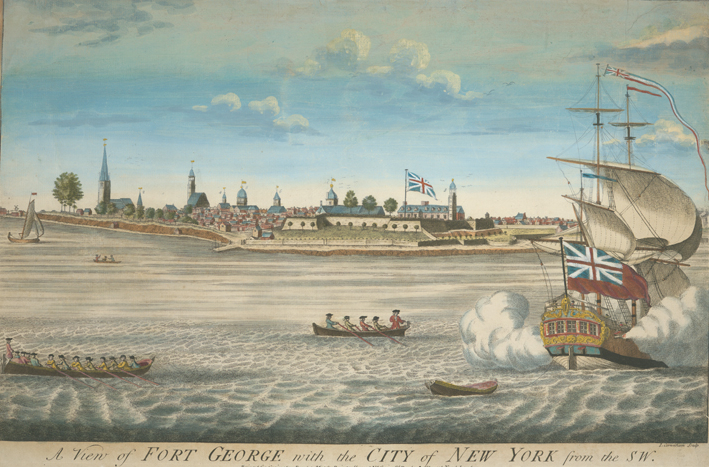Our first stop is Fort George, which no longer exists, but on its site can now be found the Alexander Hamilton U.S. Custom House, which now houses the Museum of the American Indian. Fort George, originally Fort Amsterdam, was built by the Dutch in 1626. Once under English control, the fort was called Fort James, Fort Anne and lastly Fort George after 1714. The structure burned down in 1741 in an instance blamed on slaves, but was rebuilt.[1] Fort George was the site of multiple conflicts during the Revolutionary period. In 1765, the British passed the Stamp Act, which made it so that certain pieces of paper, from legal documents to newspapers to decks of cards, had to have a special stamp that was produced in England. The British, prior to the French and Indian War, had been pretty “hands-off” when it came to governing the North American colonies, but this changed following the conflict. They needed money not only to pay for the war, but also because of the large amount of land they gained from the French. Because the colonists were not used to so much intervention from the British government, they were not happy and acted accordingly. There were opponents to the Stamp Act and other taxes by people who would become patriots and loyalists. Both camps opposed the taxes, but the divide starts to be seen as they differed on the best way to rectify the situation.
The Stamp Act Congress met in New York City in October 1765 at what is now known as Federal Hall not far from Fort George. It was the first intercolonial congress, though representatives from only nine of the thirteen colonies attended. In the resolutions drafted by the Congress, it is clear that colonists, while unhappy, were in no way looking at independence at this point in time. The taxes, according to the colonists, had “a manifest tendency to subvert the rights and liberties of the colonists.”[2] They believed that only their own legislative bodies had the right to tax them. In addition to this peaceful approach to dissention, incidents at Fort George show not-so-peaceful encounters. Fort George, in 1765, was not well defended. Lieutenant Governor of New York, Cadwallader Colden, worried after hearing of the treatment of stamp distributors in other colonies, requested soldiers from the British Army to protect the fort. He hoped this would discourage violent opposition. He was wrong. The first shipment of stamps to arrive in New York harbor on October 23, 1765 was greeted by a mob, and had to be unloaded in the middle of the night.[3] These stamps were then kept at Fort George. On October 31, the day before the Stamp Act was to be enforced, mobs took to the streets, and “Emboldened by numbers and drink, the mob swarmed to within ten feet of the fort’s gate and taunted the garrison of fewer than two hundred to fire.”[4] Physical violence did not break out between the two sides, but this showed the power of the mob and its power to intimidate. In the summer of 1789, about six years after the British surrender, Fort George, which represented British power, was destroyed.[5]
[1] Jill Lepore, New York Burning: Liberty Slavery, and Conspiracy in Eighteenth-Century Manhattan (New York: Vintage Books, 2005), 41.
[2] “Resolutions of the Stamp Act Congress,” 1765, Resolutions of the Stamp Act Congress (January 2, 2009): 1. Points of View Reference Center, EBSCOhost (accessed November 12, 2016).
[3] Philip Ranlet, The New York Loyalists. 2nd ed. (Lanham, Maryland: University Press of America, 2002), 12.
[4] Ibid., 13.
[5] Edwin G. Burrows and Mike Wallace, Gotham: A History of New York City to 1898 (New York: Oxford University Press, 1998), 300.
*Photo: William Burgis (artist) and John Carwitham (engraver), “A view of Fort George with the city of New York, from the SW,” engraving, 1731-1736, https://commons.wikimedia.org/wiki/File:A_view_of_Fort_George_with_the_city_of_New_York,_from_the_SW.jpg (accessed December 8, 2016).
